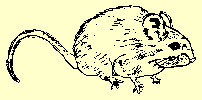What's the Habitat Like?
There are over 30 acres of the fast-disappearing coastal sage scrub community in the west and across the front, witha number of species categorized as of special concern.
Since much of Claremont was covered with coastal sage scrub before the city was developed, it is a fascinating window into the past.
There is a stand of oak woodland in the north where water wells up along an earthquake fault, there is annual grassland slowly returning to coastal sage scrub in the east, and there is a one-acre, man-made lake excavated in 1978 which is a sanctuary for western pond turtles displaced by development.
|
LEEP Ahead!
Congratulations to Paul Faulstich and Pitzer College forstarting this program!
Over the past three years, the Leadership in Environmental Education Partnership (LEEP) program has enabled 400 school children from schools in Pomona and Claremont to study ecological and environmental issues at the Bernard Biological Field Station. Once each week for 11 weeks, college students teach the children about ecology and environmental concerns in our community. The children also learn about the college experience and are introduced to positive role models and mentors.
LEEP provides hands-on lessons in environmental awareness and appreciation, ecological diversity, habitat restoration and pollution prevention. Learning about nature from direct contact is important; book learning alone is not enough to understand or reduce human impacts on the natural world. As our remaining natural areas decrease, we need to learn how to do a better job of managing the remaining fragments of wildness.
By helping children to understand and appreciate their local environment, the program also fosters good citizenship and social responsibility. It encourages children to be active rather than passive; to take control of their learning and allows them to experience the thrill of discovery.
Each issue will introduce a plant and an animal |
Rats! (Woodrats, that is)
The desert woodrat, Neotoma lepida, is one of the many charming inhabitants of the Field Station. These nocturnal mammals are gray above and white below, and about a foot long with nine-inch, furry tails.

They are often called "packrats" because of the "houses" they make in the base of shrubs using sticks, rocks, dried manure, tin cans, discarded pens, and just about anything else they can find. They eat assorted plant material, including cactus pads which, in the hot, dry summer, provide them with water.
Three or four babies arrive in spring and they hold on to the teats tenaciously. In fact, if the mother is forced to leave the nest suddenly, she may drag them along with her!
Owls, snakes, and coyotes all eat woodrats, so student research on the relationship between number of woodrats and the type of vegetation helps to shed light on how these tasty morsels reduce their chances of becoming dinner.
Dodder (that orange, thread-like stuff)
Love-vine, Strangle-weed, Witch Hair, and Golden Thread are all common names for Cuscuta californica, more prosaically known as Dodder.
This parasitic plant germinates on the ground and sends out long shoots which twine around nearby plants. The shoots send out extensions which grow into the gas- exchange openings normally present in the leaves of their victims and tap into the water and food conducting tissues of the host. The unwelcome guest loses its chlorophyll and grows into the tangled mass of brilliant yellow-orange threads which cover many Coastal Sage Scrub plants.
Although it looks peculiar, Dodder is a flowering plant, and produces tiny, white flowers in October. Fortunately, Dodder flowers are a principal food plant for caterpillars of the Western Brown Elfin butterfly which eat the buds and slow the spread of this fascinating parasite.